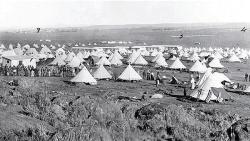
Published date
16 July 1901
The Fawcett Commission headed by Millicent Fawcett in 1901, was established as a result of an outcry against the treatment of Afrikaners in concentration camps during the South African War. A British woman, Emily Hobhouse became the champion of Afrikaners after investigating degrading conditions in these camps. Her findings were key to the setting up of the Fawcett Commission. Her report was tabled in the Westminister Parliament in June 1901 and the British Colonial Office responded by appointing a Six Woman Commission to address her findings. The commission included Jane Waterson, daughter of the British General, who was critical of Hobhouse. The appointment of Waterson was seen as an attempt to cover up the ill treatment in the camps. The commission was tasked with looking at living conditions of women and children, including water supply, sanitation, medical care and the mortality and birth rates in the camps.
The Commission visited almost every concentration camp in South Africa. They found that the camps in the Orange Free State and Transvaal were the most inhumane. Here, up to 3 500 captives shared nine toilets. Contrary to a common perception that only White people were kept in these camps, some 14 000 Black people died in them. By 1902 there were 27 927 deaths in the concentration camps comprising 1 676 men, 4 177 women and 22 074 children.
Concentration camp (Source:http://users.westconnect.com.au/~ianmac5/abw3.jpg)
Sources: Potgieter, D.J. (ed)(1971). Standard Encyclopedia of Southern Africa Vol. 3, Cape Town: Nasou, pp. 378 - 380. Barker, B. J. et al (1989). Illustrated History of South Africa: The Real story, Cape Town: Reader's Digest Association. Links: www. Joburg.org.za/november/warvictims.stm www-sul.stanford.edu/depts/ssrg/africa/pplc13.html
http://abw.netfirms.com/destruct1.htm - Images of Concentration Camps in South Africa